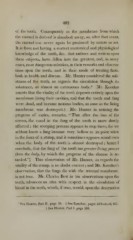Page 466 - My FlipBook
P. 466
462
of the tooth. Consequently as the membrane from which
the enamel is derived is absorbed away, so, after that event,
the enamel can never again be produced by nature or art.
It is from not having a correct anatomical and physiological
knowledge of the teeth, &c. that authors and writers upon
these subjects, have fallen into the greatest, and, in many
cases, most dangerous mistakes, in their remarks and observa-
tions upon the teeth, and in their mode of treating them,
both in health and disease. Mr. Hunter considered the sub-
stance of the teeth, as regards the circulation through its
substance, as almost an extraneous body.* Mr. Koecker
asserts that the vitality of the teeth depends entirely upon the
membrane lining their cavities, and that the tooth and fang
were dead, and became noxious bodies, as soon as the lining
membrane was destroyed-! Mr. Hunter in noticing the
progress of caries, remarks, " That after the loss of the
crown, the canal in the fang of the tooth is more slowly
affected ; the scooping process appears to stop there, for we
seldom know a fang become very hollow to its point when
in the form of a stump, and it sometimes appears sound even
when the body of the tooth is almost destroyed ; hence I
conclude, that the fang of the tooth has greater living powers
than the body, by which the progress of the disease is re-
tarded.";}; This observation of Mr. Hunter, as regards the
vitality of the stump, is no doubt correct ; and Mr. Koecker's
observation, that the fangs die with the internal membrane,
is not true. Mr. Charles Bew in his observations upon the
teeth, advances an idea with respect to the circulation of
blood in the teeth, which, if true, would, upon the destruction
See Hunter, Part II. page 39. t See Koecker, pages 254—5—6, 427.
% See Hunter, Part I. page 138.


